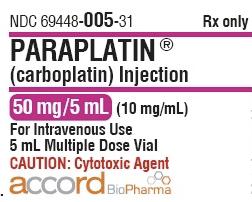Paraplatin Dosage
Generic name: CARBOPLATIN 10mg in 1mL
Dosage form: injection
Drug class: Alkylating agents
Medically reviewed by Drugs.com. Last updated on Aug 19, 2022.
NOTE: Aluminum reacts with carboplatin causing precipitate formation and loss of potency, therefore, needles or intravenous sets containing aluminum parts that may come in contact with the drug must not be used for the preparation or administration of Paraplatin ®.
Single Agent Therapy
Paraplatin ® injection, as a single agent, has been shown to be effective in patients with recurrent ovarian carcinoma at a dosage of 360 mg/m 2 IV on day 1 every 4 weeks (alternatively see Formula Dosing). In general, however, single intermittent courses of carboplatin should not be repeated until the neutrophil count is at least 2,000 and the platelet count is at least 100,000.
Combination Therapy with Cyclophosphamide
In the chemotherapy of advanced ovarian cancer, an effective combination for previously untreated patients consists of:
Paraplatin ®-300 mg/m 2 IV on day 1 every 4 weeks for 6 cycles (alternatively see Formula Dosing).
Cyclophosphamide-600 mg/m 2 IV on day 1 every 4 weeks for 6 cycles. For directions regarding the use and administration of cyclophosphamide please refer to its package insert. (See CLINICAL STUDIES.)
Intermittent courses of Paraplatin ® in combination with cyclophosphamide should not be repeated until the neutrophil count is at least 2,000 and the platelet count is at least 100,000.
Dose Adjustment Recommendations
Pretreatment platelet count and performance status are important prognostic factors for severity of myelosuppression in previously treated patients.
The suggested dose adjustments for single agent or combination therapy shown in the table below are modified from controlled trials in previously treated and untreated patients with ovarian carcinoma. Blood counts were done weekly, and the recommendations are based on the lowest post-treatment platelet or neutrophil value.
| Platelets | Neutrophils | Adjusted Dose * (From Prior Course) |
|
||
| > 100,000 | > 2,000 | 125% |
| 50-100,000 | 500-2,000 | No Adjustment |
| < 50,000 | < 500 | 75% |
Paraplatin ® injection is usually administered by an infusion lasting 15 minutes or longer. No pre- or post-treatment hydration or forced diuresis is required.
Patients with Impaired Kidney Function
Patients with creatinine clearance values below 60 mL/min are at increased risk of severe bone marrow suppression. In renally-impaired patients who received single agent carboplatin therapy, the incidence of severe leukopenia, neutropenia, or thrombocytopenia has been about 25% when the dosage modifications in the table below have been used.
| Baseline Creatinine Clearance | Recommended Dose on Day 1 |
| 41 - 59 mL/min | 250 mg/m 2 |
| 16 - 40 mL/min | 200 mg/m 2 |
The data available for patients with severely impaired kidney function (creatinine clearance below 15 mL/min) are too limited to permit a recommendation for treatment.
These dosing recommendations apply to the initial course of treatment. Subsequent dosages should be adjusted according to the patient's tolerance based on the degree of bone marrow suppression.
Formula Dosing
Another approach for determining the initial dose of Paraplatin ® injection is the use of mathematical formulae, which are based on a patient's pre-existing renal function or renal function and desired platelet nadir. Renal excretion is the major route of elimination for carboplatin. (See CLINICAL PHARMACOLOGY.) The use of dosing formulae, as compared to empirical dose calculation based on body surface area, allows compensation for patient variations in pretreatment renal function that might otherwise result in either underdosing (in patients with above average renal function) or overdosing (in patients with impaired renal function).
A simple formula for calculating dosage, based upon a patient's glomerular filtration rate (GFR in mL/min) and Paraplatin ® injection target area under the concentration versus time curve (AUC in mg/mL•min), has been proposed by Calvert. In these studies, GFR was measured by 51Cr-EDTA clearance.
CALVERT FORMULA FOR CARBOPLATIN DOSING
Total Dose (mg) = (target AUC) × (GFR + 25)
Note: With the Calvert formula, the total dose of Paraplatin ® is calculated in mg, not mg/m 2.
The target AUC of 4 mg/mL•min to 6 mg/mL•min using single-agent carboplatin appears to provide the most appropriate dose range in previously treated patients. This study also showed a trend between the AUC of single-agent carboplatin administered to previously treated patients and the likelihood of developing toxicity.
| % Actual Toxicity in Previously Treated Patients | ||
| AUC (mg/mL•min) | Gr 3 or Gr 4 Thrombocytopenia | Gr 3 or Gr 4 Leukopenia |
| 4 to 5 | 16% | 13% |
| 6 to 7 | 33% | 34% |
Geriatric Dosing
Because renal function is often decreased in elderly patients, formula dosing of Paraplatin ® based on estimates of GFR should be used in elderly patients to provide predictable plasma Paraplatin ® AUCs and thereby minimize the risk of toxicity.
PREPARATION OF INTRAVENOUS SOLUTIONS
Paraplatin ® injection is a premixed aqueous solution of 10 mg/mL carboplatin.
Paraplatin ® aqueous solution can be further diluted to concentrations as low as 0.5 mg/mL with 5% Dextrose in Water (D 5W) or 0.9% Sodium Chloride Injection, USP.
When prepared as directed, Paraplatin ® aqueous solutions are stable for 8 hours at room temperature (25°C). Since no antibacterial preservative is contained in the formulation, it is recommended that Paraplatin ® aqueous solutions be discarded 8 hours after dilution.
Frequently asked questions
- Why give Taxol (Paxel) before carboplatin?
- How does carboplatin stop cancer?
- Does carboplatin cause neuropathy?
More about Paraplatin (carboplatin)
- Check interactions
- Compare alternatives
- Pricing & coupons
- Reviews (2)
- Drug images
- Side effects
- Dosage information
- During pregnancy
- Drug class: alkylating agents
- Breastfeeding
- En español
Patient resources
Professional resources
Related treatment guides
Further information
Always consult your healthcare provider to ensure the information displayed on this page applies to your personal circumstances.


